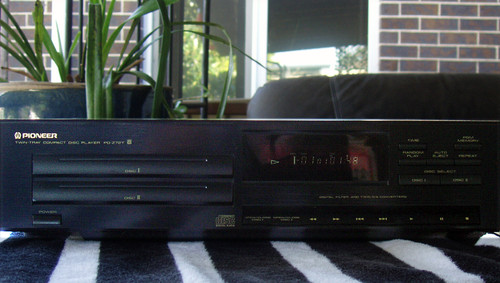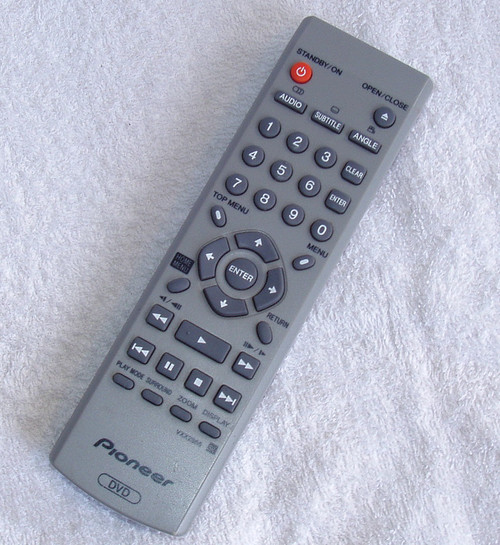Here is a very nice, mid range manual turntable from Pioneer.
This turntable was one of a number we had in our previous audio post production facilities, archival division. Our main focus was in the "black art" of mastering and editing work but we also spent a lot of time in the weird and wacky world of archival work. Weird and wacky because we were dealing with a lot of material that pre-dated RIAA standards, not even rotational speeds were standard and it was REALLY HARD to lift decent audio off a cardboard record! We dealt with ALL types of media ranging from WWII cardboard recordings from Australian soldiers abroad through to modern vinyls and transferring them to a more stable media, usually CD but staying in the analog domain for as long as possible.
This PL-510A turntable kept company in our archival studio's with our Linn LP12's, Rega's and Technics SP1's and in the right situation, did it's job very well.
To have a PL-510A is certainly something to be proud of, and a great starting point to enter the amazing world of vinyl music
PIONEER Manual Turntable
Designed & Made in Japan
33 & 45 RPM
Model: PL-510A
NO CARTRIDGE HEAD IS FITTED - Please read below why this is the case
Manual tonearm control
Direct drive (no belts to change!) servo controlled to ensure accurate playback speed
Floating platter & tonearm assembly
Aluminium alloy platter
Heavy duty clear perspex dust cover/hinged lid
Released to the marketplace 1976 - 1978
Wow and flutter: 0.03%
Signal-Noise Ratio (Rumble): 68dB (quoted by the manufacturer using the original Pioneer head cartridge)
Overall weight is 8Kg
Australian model fitted with the correct power plug
Supplied with the ORIGINAL Pioneer user manual - this is VERY useful to a newcomer in the world of vinyl
Nice "newbee" vinyl enthusiasts turntable, a quality product from Pioneer but with features missing to keep costs down (fully manual, no auto "anything")
While this turntable cannot be considered in the class of audiophile equipment, it does a decent job and is a vast improvement over later turntables which were "el cheapo plastic jobbie" turntables that the Japanese in particular released to the market, all plastic/light as a feather and made at low cost to meet a low level consumer "price point"
So this turntable is great for a starter in the wonderful world of analog vinyl or someone who is looking to upgrade their "very basic" turntable.
SPECIFIC DESIGN DETAILS:
4x feet on the base are spring loaded, this improves acoustic isolation of the turntable from the surface it is sitting on
The platter/tonearm assembly is floating
Strobe light indicates the selected speed is correct BUT you can also manually vary the speed very precisely on both 33 or 45
Very nice precise anti-skate control
Simple user controls:
Speed select - two buttons, one for 33 and the other for 45
Speed adjust - two rotary controls
ON - Lift - Lower lever switch
That's about it - Pioneer has focused on simplicity of use, there are NO features such as:
NO automatic tonearm movement, it is not semi-automatic or fully automatic. You (the lover of vinyl) need to use the lever switch to raise the arm, then move the tonearm over to the run-in area (or selected track) and then using the switch, lower the arm. Same goes for the run-out area (unless you like the sound of ker chunk ker chunk ker chunk as the tonearm keeps riding in the run-out grooves)
This is NOT a disadvantage, particularly if you want the "professional radio station presenter" experience. These were the days when the presenter would carefully move the tonearm into position, cue the record ready to play, wind back the platter just a little and then usually hold the slip mat and release it to begin play. Of course radio stations didn't use this model turntable, more likely to be something like the wonderful Technics SP1 (a couple of them usually) were used.
COSMETIC CONDITION:
This has been always sitting in our "archival studio" and looked after, like all of our turntables.
The wooden base, all of the woodgrain veneer sides are in excellent condition - not even marked although I should point out that an ID number has been engraved on the rear side to help in identification should someone steal the turntable.
The dust cover/hinged lid also has no substantial scratches or marks - extremely clean.
I have already been asked "what does 'substantial scratches or marks" mean? Over the years I have seen some shockingly bad dust covers, cigarette burns, massive cracks or even whole sections missing and often one or both hinges have disappeared.
THIS dust cover is (in my opinion) in VERY GOOD condition, not so far off being excellent. The material used is real perspex, it is very thick and well formed. There are NO cracks, not even around the hinges. There is a light mark (and I mean light) at the rear near the corner, this is certainly no cause for alarm. The top and sides have some VERY LIGHT scuff type marks and that's all - no liquid spill marks, no gouging, no cracks of any kind.
Not only is this turntable a great player, it looks the part too - very retro but also very attractive and "cool"
The dust cover hinges actually work! Raise the dustcover and it stays in place.
If you wished to clean the dustcover or remove it completely, this is very easy to do. Just open the dustcover lid, lift carefully and the hinge will come apart so you can set the whole dust cover lid to one side.
Top side of the deck is very clean with no damage to any part. The platter has very light oxidisation "spots" around the rim (just above the strobe pattern) but nothing serious, it just looks a little bit "dull".
The original mat is clean and undamaged.
PLEASE NOTE: The mat did have an aluminium ring in the centre. This ring is supplied but is not attached to the mat any longer - we found it to be a nuisance in our work and just set it aside.
Genuine Pioneer 45 adaptor is supplied
All knobs and buttons are clean and undamaged
Tonearm is in excellent condition, including the tonearm lock.
PLEASE NOTE: It is while inspecting the tonearm more closely that I noticed two minor issues, please read my description under TESTING for details.
Original Pioneer User Manual is in very good condition albeit slightly yellowed over the years.
TESTING:
These PL-510A turntables, by nature of their design, are very very reliable and certainly never gave us an issue but as this has been carefully stored away when I closed down the audio post production business, its time for a good thorough testing and observation of the turntable once more ....
The supplied user manual is extremely handy, particularly for the vinyl "new-comer"
The manual describes these things:
PL-510A features
Attaching the cartridge
Assembly steps
Component locations
Tonearm adjustments
Stereo Amplifier connections
Dust Cover
Panel Facilities
Operation
Caring for your turntable
Conditions for frequently mistaken "malfunctions"
Specifications
One of the most important chapters is Tonearm adjustments. This covers adjustment of the counter-weight, adjustment of the lateral balance weight, stylus over-hang adjustment and if you were using a "heavy cartridge", fitting of the additional sub-weight.
It is at this point that I noticed THE LATERAL BALANCE WEIGHT AND ARM ARE MISSING! These cannot just fall off (secured with a grub screw) so I expect our sound engineer decided it was not needed but I cannot locate the lateral arm & balance so these are NOT supplied.
This is not the end of the world, the lateral balance is designed to equalise the load on the pivot bearings... balancing the tone arm side to side. As long as the turntable is placed on a completely level surface, the use of this lateral balance weight (or the lack of one) is not going to change the world dramatically or your audio output. It's just a nice thing to have even wear on each side of the pivot bearings. If this really bothers you, I would imagine it is not hard to find the lateral arm and balance anyway - many S shaped tonearms use these.
The second thing I noticed, although it actually has never been needed when we used the turntable is the sub-weight. This is needed ONLY when the head cartridge being used weighs more than 8.5g - it simply screws into the far end of the tonearm to provide additional weight to the counter balance. We never used a cartridge this heavy so with "normal" cartridges, you will never need to have one of these sub-weights. For example, this Shure 15 IV I am using weighs 6.5g and this would be pretty typical of most "common" head cartridges.
Stylus over-hang is slightly more tricky. Stylus over-hang is the arc that the tip of the stylus traverses as it plays across the record, from the outer edges into the inner run-out area (unless you have some weird vinyl which runs from the inside out! I came across one of those not so long ago - weird pressing and an absolute dog to play with an auto turntable!)
With a new head cartridge it is likely to come with an overhang gauge but failing this, it is not difficult to find arc protractors online or download software that will create one for you - a good starting point is this website which is full of useful, interesting turntable related "stuff" http://conradhoffman.com/chsw.htm
Please keep in mind that NO HEAD CARTRIDGE will be supplied with this turntable.
To prevent any misunderstanding, I am talking about the head cartridge only (where the styli is fitted) - of course the head SHELL is supplied!
In our previous specialised archival studio use we would often change out the head cartridge depending upon the material we were being asked to create an archival copy of - every cartridge has different characteristics that suit particular types of media or media condition.
In fact you can see a holder on this turntable up in the left hand corner. Sure it is usually considered to be for storing the 45 adaptor but it actually is also designed to hold a spare headshell assembly. This made life great for us, just pop off the old headshell and fit the new headshell which had a different head cartridge fitted and ready to go.
For my testing I am currently running a Shure 15 IV with this tonearm (around 20 albums per day at the moment) but that cartridge is about to head off to New Zealand, leaving the turntable without a head once more (and a turntable which has no head is not a pretty thing to see!)
There are many, many cartridges that will sound great with this arm, for some ideas have a look around the forums talking about this turntable - you could try Googling "Pioneer PL-510A cartridge" and are sure to have many hits with forums discussing these well considered turntables and which cartridges "suit" them best.
I WILL supply the 2x cartridge mounting bolts - all you need to do is find yourself a good decent standard mount cartridge (with a NEW styli, never ever use a second hand styli with unknown useage/condition), carefully fit the 4 wires at the rear of the cartridge and you are in business.
First I checked the speed and speed adjustment controls. All is fine and dandy, no issues at all here.
The turntable spins up rapidly at switch on, settles down to a stable and correct speed as indicated by the strobe light. Adjustment of the speed (slower or faster) worked smoothly. I also noted any shift in speed "lock" - there was none. I even forced the platter to slow right down by introducing friction (my hand!) and watched how quickly it recovered - no problem here at all, it spun back up to the correct speed and stayed there. I also noticed there was plenty of torque.
These speed tests were done at both 33 and 45.
Next is the lowering and lifting mechanism. This is totally mechanical and controlled with the lever switch on the front right-hand side. It is not just a case of "drop the tonearm or raise the tonearm" but by careful partial movement of this lever you can control the height of the tonearm (to better judge the correct position on the vinyl to begin play) or you can simply move the lever fully towards you and the tonearm does smoothly and gently lower itself to the vinyl surface.
Raising the tonearm is also a smooth, gentle movement - the tonearm doesn't just "jump up" out of the groove!
While rotating without any vinyl playing, the turntable runs practically silent - no motor noise at all.
I also checked the condition of the spring suspended feet (4) and they are all fine, these are quite important to acoustically isolate the turntable from the surface it is sitting on and help to reduce resonances.
If I was going to make any negative comment it would be that although the audio output cable is a nice heavy grade, the nickel plated RCA's on the each channel are rather "el-cheapo" moulded types. If you wanted to go to the trouble, cut off the existing RCA's and fit some decent gold plated connectors to ensure a much more reliable (and possibly lower noise) connection with the preamplifier or amplifier.
LATE NOTE (After almost 50 years, nothing is perfect)
At this late stage of testing the turntable I decided to check one last thing, the foam/sponge "matt" that sits between the motor board and the top of the turntable - this is a vital part of the floating platter/tonearm system. Although the foam feels "OK" I am suspicious of the condition as it looks to have started disintegrating due to age. This is a really common problem with "old foam" although I have seen it far more in microphones of old.
It would be sensible (and later on, necessary) to replace this foam sheet - getting the correct thickness of foam shouldn't be difficult (Clarke Rubber comes to mind) and use the old foam sheet as a template.
Access inside is not difficult - 8x wood screws hold the shielded base in place and then you will see the 4x spring pillars used for the suspension system. Undo the central screws in the pillars plus a couple more screws and the whole motor board lifts up. You will still need to disconnect the tonearm from this board but once done, full access is then available for replacing of the foam.
It would be a very sensible idea once the new owner receives this turntable, take off the base, remove the earth clip (for the shielding) and adjust/check the 4x black pillar screw adjustments - these are where you adjust the "floating" of the motor board. Too tight and the floating will not work (evident by increased turntable rumble in the audio) and if too loose, the platter will move around too much, like a pogo stick!
I have now fitted the 4x transit bolts and these MUST be removed (philips head) before using the turntable, otherwise the floating platter/tonearm will be extremely rigid!
I have taken a photograph of where these bolts are, pretty conspicuous so they will be easy to locate and remove.
I can safely send this turntable anywhere around Australia or internationally - the lid, platter, rubber matt, headshell and other small accessories will be packed separately - these are all easy to re-assemble and the User Manual gives you clear and concise guides anyway.
Finally (phew!) MY DESCRIPTION ENDS
I will send a copy of this advertisement with the turntable because once purchased on my website, the advertisement can no longer be viewed and there is a ton of information in this description - my intention is to always give a full and complete description of an item that I am offering, otherwise how could a person make an informed decision about an item I am offering?

















